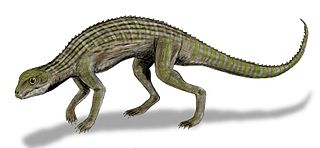 W
WAdamantinasuchus is an extinct genus of notosuchian crocodylomorph from and named after the Late Cretaceous Adamantina Formation of Brazil. It is known from only one fossil, holotype UFRJ-DG 107-R, collected by William Nava. The fossil consists of a partial skull, fragmentary limb bones and a few brokenen vertebrae, and was found 25 km SW of the town of Marilia, near a reservoir dam. Adamantinasuchus was approximately 60 cm long from nose to tail, and would have only weighed a few kilograms.
 W
WAgaresuchus is an extinct genus of allodaposuchid once known as "Allodaposuchus" subjuniperus. It was recovered from the late-Maastrichtian Conquès Formation, part of the Tremp Group, in the province of Huesca, Spain. It was found in the Amor-3 layer.
 W
WAllodaposuchidae is an extinct clade of basal eusuchians that lived in southern Europe during the Late Cretaceous (Santonian-Maastrichtian).
 W
WAplestosuchus is an extinct genus of baurusuchid mesoeucrocodylian known from the Late Cretaceous Adamantina Formation of São Paulo, southern Brazil. It contains a single species, Aplestosuchus sordidus. A. sordidus is represented by a single articulated and nearly complete skeleton, preserving the remains of an unidentified sphagesaurid crocodyliform in its abdominal cavity. The specimen represents direct evidence of predation between different taxa of crocodyliforms in the fossil record.
 W
WAraripesuchus is a genus of extinct crocodyliform that existed during the Cretaceous period of the late Mesozoic era some 125 to 66 million years ago. Six species of Araripesuchus are currently known. They are generally considered to be notosuchians, characterized by their varied teeth types and distinct skull elements. This genus consists of other five related species: A. wegeneri and A. rattoides, discovered in Niger, A. tsangatsangana, discovered in Madagascar, A. gomesii, discovered in Brazil and another species discovered in Argentina, A. patagonicus.
 W
WArmadillosuchus is an extinct genus of sphagesaurid crocodylomorph. It was described in February 2009 from the late Campanian to early Maastrichtian Adamantina Formation of the Bauru Basin in Brazil, dating to approximately 70 Ma. Armadillosuchus length was estimated on 2 metres (6.6 ft) with an estimated body mass of 120 kg (260 lb).
 W
WBaurusuchidae is a Gondwanan family of mesoeucrocodylians that lived during the Late Cretaceous. It is a group of terrestrial hypercarnivorous crocodilians from South America and possibly Pakistan. Baurusuchidae has been defined as a clade containing the most recent common ancestor of Baurusuchus and Stratiotosuchus and all of its descendants. It may, however, be polyphyletic, as recent phylogenetic analyses have placed Baurusuchus within Notosuchia and other baurusuchids within the more distantly related clade Sebecia. A recent study of the family finds it monophyletic by including the South American genera Baurusuchus, Cynodontosuchus, Pissarrachampsa, Stratiotosuchus, and Wargosuchus. Other traditional baurusuchids like Pabwehshi are excluded. The recently named Campinasuchus is also included in the family. Baurusuchids have been placed in the suborder Baurusuchia, and two subfamilies have been proposed: Baurusuchinae and Pissarrachampsinae.
 W
WBaurusuchinae is a subfamily of baurusuchid crocodyliforms from the Late Cretaceous of Brazil. Named in 2011, it contains the baurusuchids Baurusuchus and Stratiotosuchus. Baurusuchinae is one of two subfamilies of Baurusuchidae, the other being Pissarrachampsinae.
 W
WBaurusuchus is an extinct member of the ancestral crocodilian lineage, which lived in Brazil from 90 to 83.5 million years ago, in the Late Cretaceous period. Technically, it is a genus of baurusuchid mesoeucrocodylian. It was a terrestrial predator and scavenger, about 3.5 to 4 metres long and 80 kilograms (176 lb) in weight. Baurusuchus lived during the Turonian to Santonian stages of the Late Cretaceous Period, in Adamantina Formation, Brazil. It gets its name from the Brazilian Bauru Group. It was related to the earlier-named Cynodontosuchus rothi, which was smaller, with weaker dentition. The three species are B. pachechoi, named after Eng Joviano Pacheco, its discoverer, B. salgadoensis and B. albertoi. The latter species is disputed. Its relatives include the similarly sized Stratiotosuchus from the Adamantina Formation, and Pabweshi, from the Pakistani Pab Formation.
 W
WBergisuchus is an extinct genus of small sebecosuchian mesoeucrocodylian known primarily from the Eocene Messel Pit in Germany. Few fossils of Bergisuchus have been discovered, only a single incomplete snout, a few partial lower jaws and some teeth. Despite being fragmentary, the jaw bones are enough to indicate that Bergisuchus had a short, deep, narrow snout and serrated teeth, quite unlike the broad flat snouts of modern crocodylians.
 W
WBoverisuchus is an extinct genus of planocraniid crocodylian known from the middle Eocene of Germany and possibly North America. It grew to approximately three metres (10 ft) in length.
 W
WCaipirasuchus is an extinct genus of sphagesaurid notosuchians known from the Late Cretaceous of northern São Paulo State, southeastern Brazil. The type species, C. paulistanus, was named in 2011. A second species, C. montealtensis, was referred to Caipirasuchus in 2013 after having been named in 2008 as a species of Sphagesaurus. A third species, C. stenognathus, was described in 2014. A fourth species, C. minerius, was described in 2018.
 W
WCampinasuchus is an extinct genus of baurusuchid mesoeucrocodylian from Minas Gerais State of Brazil.
 W
WChimaerasuchidae is a family of mesoeucrocodylians. It was erected as a clade in 2004 by Carvalho et al and included Chimaerasuchus from the Early Cretaceous of China and possibly also Simosuchus from the Late Cretaceous of Madagascar. The validity of the clade has been questioned in later studies that found the two genera to be more distantly related.
 W
WChimaerasuchus is an extinct genus of Chinese crocodyliform from the Early Cretaceous Wulong Formation. The four teeth in the very tip of its short snout gave it a "bucktoothed" appearance. Due its multicusped teeth and marked heterodonty, it is believed to have been an herbivore. Chimaerasuchus was originally discovered in the 1960s but not identified as a crocodyliform until 1995, instead thought to possibly be a multituberculate mammal. It is highly unusual, as only two other crocodyliforms have displayed any characteristics resembling its adaptations to herbivory.
 W
WComahuesuchidae is a family of notosuchian crocodyliforms. Constructed in 1991, it includes the genera Comahuesuchus and Anatosuchus. Among the characteristics that are unique to this family is an external naris that is inset into the tip of the snout. There is also a diastema, or gap between the teeth, at the tip of the upper and lower jaws. Both Anatosuchus and Comahuesuchus have maxillary tooth rows in the upper jaw that extend out and over the dentary tooth rows of the lower jaw.
 W
WDibothrosuchus is a genus of sphenosuchian, a type of basal crocodylomorph, the clade that comprises the crocodilians and their closest kin. It is known from several partial skeletons and skulls. These fossils were found in Lower Jurassic rocks of Yunnan, China. Dibothrosuchus was a small terrestrial crocodylomorph that probably had a keen sense of hearing, and thus was probably a vocal animal like modern crocodilians.
 W
WGobiosuchidae is a family of Cretaceous crocodyliforms known from Mongolia and Spain.
 W
WGobiosuchus was a gobiosuchid crocodyliform described in 1972 by Polish palaeontologist Halszka Osmólska. It hails from the Late Cretaceous of Bayn Dzak, in the Gobi Desert of Mongolia.
 W
WHallopus was a prehistoric reptile, named in 1877 as a species of Nanosaurus and classified by O. C. Marsh in 1881 as a dinosaur, but now thought to be a pseudosuchian more closely related to crocodilians. It was a quite small animal, reaching a length of 1 m (3.3 ft). It was redescribed as a sphenosuchian crocodylomorph. Later, it was speculated to be more derived than Sphenosuchus and near or within the Junggarsuchus + Crocodyliformes node.
 W
WHamadasuchus is an extinct genus of sebecian crocodylomorph. Fossils have been found from the Kem Kem Formation outcropping in southeastern Morocco. These beds date back to the Albian and Cenomanian stages of the Late Cretaceous. It was first assigned to the family Trematochampsidae. Diagnostic features of the genus include its lateromedially compressed and serrated teeth. It was deep-snouted and had a slightly heterodont dentition with three distinct tooth morphologies present from sections of the lower jaw.
 W
WHesperosuchus is an extinct genus of crocodylomorph reptile that contains a single species, Hesperosuchus agilis. Remains of this pseudosuchian have been found in Late Triassic (Carnian) strata from Arizona and New Mexico. Because of similarities in skull and neck anatomy and the presence of hollow bones Hesperosuchus was formerly thought to be an ancestor of later carnosaurian dinosaurs, but based on more recent findings and research it is now known to be more closely related to crocodilians rather than dinosaurs.
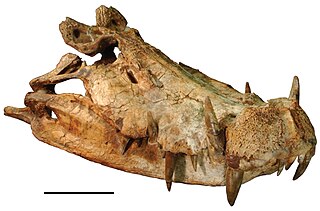 W
WKaprosuchus is an extinct genus of mahajangasuchid crocodyliform. It is known from a single nearly complete skull collected from the Late Cretaceous Echkar Formation of Niger. The name means "boar crocodile" from the Greek κάπρος, kapros ("boar") and σοῦχος, soukhos ("crocodile") in reference to its unusually large caniniform teeth which resemble those of a boar. It has been nicknamed "BoarCroc" by Paul Sereno and Hans Larsson, who first described the genus in a monograph published in ZooKeys in 2009 along with other Saharan crocodyliformes such as Anatosuchus and Laganosuchus. The type species is K. saharicus.
 W
WLibycosuchus is an extinct genus of North African crocodylomorph possibly related to Notosuchus; it is part of the monotypic Libycosuchidae and Libycosuchinae. It was terrestrial, living approximately 95 million years ago in the Cenomanian stage of the Late Cretaceous. Fossil remains have been found in the Bahariya Formation in Egypt, making it contemporaneous with the crocodilian Stomatosuchus, and dinosaurs, including Spinosaurus. It was one of the few fossils discovered by Ernst Stromer that wasn't destroyed by the Royal Air Force during the bombing of Munich in 1944. The type species, L. brevirostis, was named in 1914 and described in 1915.
 W
WLitargosuchus is a sphenosuchian crocodylomorph, a basal member of the crocodylomorph clade from the Early Jurassic of South Africa. Its genus name Litargosuchus is derived from Greek meaning "fast running crocodile" and its species name leptorhynchus refers to its gracile snout. Litargosuchus, along with all of South Africa's crocodylomorph taxa, are confined to the upper Elliot Formation (UEF) in South Africa.
 W
WMacelognathus is an extinct genus of sphenosuchian crocodylomorph from the Late Jurassic. Originally it was believed be a turtle and later a dinosaur. It lived in what is now Wyoming, in North America.
 W
WMahajangasuchidae is an extinct family of neosuchian crocodyliforms. It currently contains two genera, Mahajangasuchus and Kaprosuchus, both of which lived during the Late Cretaceous in Gondwana. It is defined as the most inclusive clade containing Mahajangasuchus insignis but not Notosuchus terrestris, Simosuchus clarki, Araripesuchus gomesii, Baurusuchus pachecoi, Peirosaurus torminni, Goniopholis crassidens, Pholidosaurus schaumbergensis, or Crocodylus niloticus. Phylogenetically, Mahajangasuchidae is placed just outside pholidosaurids and more derived neosuchians.
 W
WMariliasuchus is an extinct genus of Late Cretaceous notosuchian mesoeucrocodylian found near Marilia, Brazil. The first bone remains were found and collected in 1995 by Brazilian paleontologist William Nava, in red rocks from the fossiliferous Adamantina Formation. Four years later, it was described as Mariliasuchus amarali, by Brazilian paleontologists Ismar de Souza Carvalho and Reinaldo J. Bertini.
 W
WMekosuchus is a genus of extinct Australasian crocodiles within the subfamily Mekosuchinae. They are believed to have been made extinct by the arrival of humans on the South Pacific islands where they lived. The species of this genus were small in size, 2 m in maximum length, and terrestrial, making them the last surviving group of fully terrestrial crocodilians, leaving only semi-terrestrial species such as the Cuban crocodile and the dwarves Osteolaemus and Paleosuchus.
 W
WMontealtosuchus was an extinct genus of terrestrial crocodyliform. It was discovered in 2004 in the Bauru Basin of Brazil, from Turonian-Santonian deposits of the Adamantina Formation. The species was described in 2007, and assigned to the family Peirosauridae. The type species is M. arrudacamposi. The genus takes its name from the type locality in Monte Alto municipality.
 W
WMorrinhosuchus is an extinct genus of notosuchian crocodyliform from the Late Cretaceous Adamantina Formation of Brazil. It is known from a mandible and a portion of the front of the skull collected from the municipality of Monte Alto in São Paulo state. Morrinhosuchus refers to Morrinho de Santa Luzia, a hill nearby the collection site of the holotype, while luziae refers to the chapel of Santa Luzia, which is located on top of the hill.
 W
WNotosuchia is a suborder of primarily Gondwanan mesoeucrocodylian crocodylomorphs that lived during the Jurassic and Cretaceous. Some phylogenies recover Sebecosuchia as a clade within Notosuchia, others as a sister group ; if Sebecosuchia is included within Notosuchia its existence is pushed into the Middle Miocene, about 11 million years ago. Fossils have been found from South America, Africa, Asia, and Europe. Notosuchia was a clade of terrestrial crocodilians that evolved a range of feeding behaviours, including herbivory (Chimaerasuchus), omnivory (Simosuchus), and terrestrial hypercarnivory (Baurusuchus). It included many members with highly derived traits unusual for crocodylomorphs, including mammal-like teeth, flexible bands of shield-like body armor similar to those of armadillos (Armadillosuchus), and possibly fleshy cheeks and pig-like snouts (Notosuchus). The suborder was first named in 1971 by Zulma Gasparini and has since undergone many phylogenetic revisions.
 W
WNotosuchidae is a Gondwanan family of notosuchians. They were small-bodied terrestrial crocodyliforms that lived during the Late Cretaceous.
 W
WNotosuchus is an extinct genus of South American notosuchian crocodylomorph. It was terrestrial, living approximately 85 million years ago in the Coniacian or Santonian stages of the Late Cretaceous.
 W
WPeirosauridae is a Gondwanan family of mesoeucrocodylians that lived during the Cretaceous period. It was a clade of terrestrial crocodyliforms that evolved a rather dog-like form, and were terrestrial carnivores. It was phylogenetically defined in 2004 as the most recent common ancestor of Peirosaurus and Lomasuchinae and all of its descendants. Lomasuchinae is a subfamily of peirosaurids that includes the genus Lomasuchus.
 W
WPissarrachampsa is an extinct genus of baurusuchid mesoeucrocodylian from the Late Cretaceous of Brazil. It is based on a nearly complete skull and a referred partial skull and lower jaw from the ?Campanian - ?Maastrichtian-age Vale do Rio do Peixe Formation of the Bauru Group, found in the vicinity of Gurinhatã, Brazil.
 W
WPissarrachampsinae is a subfamily of baurusuchid crocodyliforms from the Late Cretaceous of Brazil and Argentina. It was named in 2011 with the description of Pissarrachampsa sera and includes P. sera from Brazil and the related Wargosuchus australis from Argentina. Pissarrachampsinae is one of two subfamilies of Baurusuchidae, the other being Baurusuchinae.
 W
WPlanocraniidae is an extinct family of basal crocodylians known from the Paleogene of Asia, Europe and North America. The family was coined by Li in 1976, and contains two genera, Boverisuchus and Planocrania. Planocraniids were highly specialized crocodylians that were adapted to living on land. They have extensive body armor, long legs, and blunt claws resembling hooves, and are sometimes informally called "hoofed crocodiles". Most phylogenetic analyses place planocraniids in a basal position within Crocodylia. Some of these analyses find that planocraniids lie just outside Brevirostres, the group of crocodilians that includes alligators, caimans, and crocodiles but not gharials. Planocraniids are inferred to have first appeared in the Late Cretaceous, several tens of millions of years before they actually occur in the fossil record. This is because the earliest members of Brevirostres appear in the Campanian stage of the Late Cretaceous, and Planocraniidae, being an outgroup to Brevirostres, must have branched off before this time.
 W
WProtosuchia is a group of extinct Mesozoic crocodyliforms. They were small in size and terrestrial. In phylogenetic terms, Protosuchia is considered an informal group because it is a grade of basal crocodyliforms, not a true clade.
 W
WProtosuchidae was a family of crocodylmorph reptiles from the Late Triassic, Jurassic, and Cretaceous time periods. They were closely related to the Gobiosuchidae.
 W
WProtosuchus is an extinct genus of carnivorous crocodylomorph from the Early Jurassic. The name Protosuchus means "first crocodile", and is among the earliest animals that resemble crocodilians. Protosuchus was about 1 metre (3.3 ft) in length and about 40 kilograms (88 lb) in weight.
 W
WPseudhesperosuchus is a genus of sphenosuchian, a type of basal crocodylomorph, the clade that comprises the crocodilians and their closest kin. It is known from a partial skeleton and skull found in rocks of the Late Triassic (Norian-age) Los Colorados Formation of the Ischigualasto-Villa Unión Basin in northwestern Argentina.
 W
WRedondavenator is a genus of sphenosuchian, a type of basal crocodylomorph, the clade that comprises the crocodilians and their closest kin. It is known from a partial upper jaw and left shoulder girdle found in rocks of the Norian-Rhaetian-age Upper Triassic Redonda Formation, northeastern New Mexico. It is notable for its large size; the minimum estimated skull length for the holotype individual is 60 centimetres (24 in).
 W
WSaltoposuchus is an extinct genus of small, long-tailed crocodylomorph reptile (Sphenosuchia), from the Norian of Europe. The name translated means "leaping foot crocodile". It has been proposed that Terrestrisuchus gracilis and Saltoposuchus connectens represent different ontogenetic stages of the same genus. Saltoposuchus is commonly referred to in popular literature as the ancestor to dinosaurs, however, recent scientific research show that this is not the case.
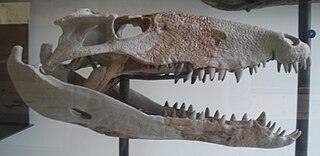 W
WSebecia is an extinct clade of mesoeucrocodylian crocodyliforms that includes peirosaurids and sebecids. It was first constructed in 2007 to include Hamadasuchus, Peirosauridae, and Sebecus. It was initially considered to be the sister taxon of the clade Neosuchia, which includes living crocodilians, although some later studies have placed it within Neosuchia as a basal clade. Sebecians were terrestrial crocodyliforms characterized by their deep snouts and ziphodont dentition. They first appeared in the Late Cretaceous, survived the Cretaceous–Paleogene extinction event, and became extinct in the Miocene epoch.
 W
WSichuanosuchus is an extinct genus of crocodylomorph from the Late Jurassic and possibly Early Cretaceous of China.
 W
WSimosuchus is an extinct genus of notosuchian crocodylomorphs from the Late Cretaceous of Madagascar. It is named for its unusually short skull. Fully grown individuals were about 0.75 metres (2.5 ft) in length. The type species is Simosuchus clarki, found from the Maevarano Formation in Mahajanga Province, although some fossils have been found in India.
 W
WSphagesauridae is a Gondwanan family of mesoeucrocodylians that lived during the Late Cretaceous. It was a clade of terrestrial crocodilians that evolved very mammal-like teeth and jaws. Both Sphagesaurus and Adamantinasuchus are known from the Turonian to Santonian of Brazil.
 W
WSphenosuchia is a suborder of basal crocodylomorphs that first appeared in the Triassic and occurred into the Middle Jurassic. Most were small, gracile animals with an erect limb posture. They are now thought to be ancestral to crocodyliforms, a group which includes all living crocodilians.
 W
WSphenosuchus is an extinct genus of crocodylomorph from the Early Jurassic Elliot Formation of South Africa, discovered and described early in the 20th century. The skull is preserved very well but other than elements of the forelimb and isolated parts of the hind limb, the Sphenosuchus material is incomplete. It was probably quadrupedal, but may have been a facultative biped.
 W
WStegomosuchus is an extinct genus of small protosuchian crocodylomorph. It is known from a single incomplete specimen discovered in the late 19th century in Lower Jurassic rocks of south-central Massachusetts, United States. It was originally thought to be a species of Stegomus, an aetosaur, but was eventually shown to be related to Protosuchus and thus closer to the ancestry of crocodilians. Stegomosuchus is also regarded as a candidate for the maker of at least some of the tracks named Batrachopus in the Connecticut River Valley.
 W
WStratiotosuchus is an extinct genus of baurusuchid mesoeucrocodylian from the Adamantina Formation in Brazil. It lived during the Late Cretaceous. The first fossils were found in the 1980s, and the type species Stratiotosuchus maxhechti was named in 2001. A hyperpredator, it and other baurusuchids may have filled niches occupied elsewhere by theropod dinosaurs.
 W
WTerrestrisuchus is an extinct genus of very small early crocodylomorph that was about 76 centimetres (30 in) long. Fossils have been found in Wales and Southern England and date from near the very end of the Late Triassic during the Rhaetian, and it is known by type and only known species T. gracilis. Terrestrisuchus was a long-legged, active predator that lived entirely on land, unlike modern crocodilians. It inhabited a chain of tropical, low-lying islands that made up southern Britain, along with similarly small-sized dinosaurs and abundant rhynchocephalians. Numerous fossils of Terrestrisuchus are known from fissures in limestone karst which made up the islands it lived on, which formed caverns and sinkholes that preserved the remains of Terrestrisuchus and other island-living reptiles.
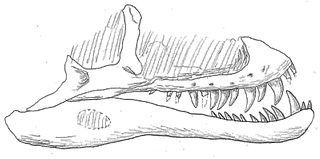 W
WTrialestes is an extinct genus of Late Triassic (Carnian) crocodylomorphs that lived in South America. It has been classified as a dinosaur in the past due it being adapted as a terrestrial, running carnivore. It is classified in Sphenosuchia, which were early relatives of crocodylians. Irmis, Nesbitt and Sues (2013) noted that some of the material referred to this taxon is actually dinosaurian; however, according to the authors, the holotype specimen PVL 2561, found in the Cancha de Bochas Member of the Ischigualasto Formation in the Ischigualasto-Villa Unión Basin in northwestern Argentina, "comprises a single individual that preserves unambiguous crocodylomorph synapomorphies", indicating it is indeed a crocodylomorph, and one of the referred specimens, PVL 3889, does share one or more autapomorphies with the holotype, indicating it represents the same taxon. The type species, T. romeri, was named in 1963.
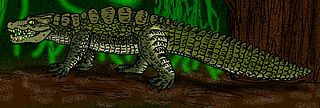 W
WTrilophosuchus is an extinct genus of mekosuchine crocodilian from Australia. Unlike living crocodilians, it is hypothesized to have been terrestrial. Trilophosuchus was approximately 1.5 metres (4.9 ft) in length. It had a short skull with three ridges on top and large eyes. Fossils have been found at Riversleigh in north-western Queensland, and are Miocene in age. Only a single species has been described, the type species T. rackhami.
 W
WUberabasuchus is an extinct genus of crocodylomorph from the Late Cretaceous Marília Formation of Brazil. It was about 2.5 metres (8.2 ft) long and appears to have a high skull like that of the sebecosuchians, but differs from them in having teeth with circular cross-section. Thus, rather than slicing flesh and blood vessels, it is likely to have inflicted powerful crushing bites. The post-crania and the geology suggesting an arid climate indicate that Uberabasuchus was likely a terrestrial predator.
 W
WUruguaysuchidae is a family of notosuchian crocodyliforms that lived in South America and Africa during the Cretaceous period. It includes the genera Araripesuchus and Uruguaysuchus. Below is a cladogram from Soto et al. (2011):
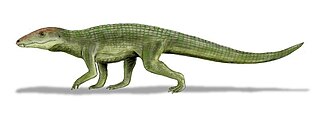 W
WUruguaysuchus is an extinct genus of crocodylomorphs from the Late Cretaceous Guichón Formation of Uruguay. It was related to Simosuchus and Malawisuchus. It was of small to moderate size reaching an estimated length of 120 centimetres (3.9 ft).
 W
WYacarerani is an extinct genus of Late Cretaceous notosuchian crocodylomorph. Fossils have been found in 2002 in the Cajones Formation in Amboró National Park of central Bolivia and are Turonian-Santonian in age. The genus was described in 2009 in the Journal of Vertebrate Paleontology. The material represents two individuals and was found in association with eggs that are thought to have been part of a nest. Yacarerani was a small crocodylomorph at around 80 centimetres (31 in) in length. It may have lived in small groups, creating burrows to lay eggs in.
 W
WZiphosuchia is a clade of mesoeucrocodylian crocodyliforms that includes notosuchians and sebecosuchia